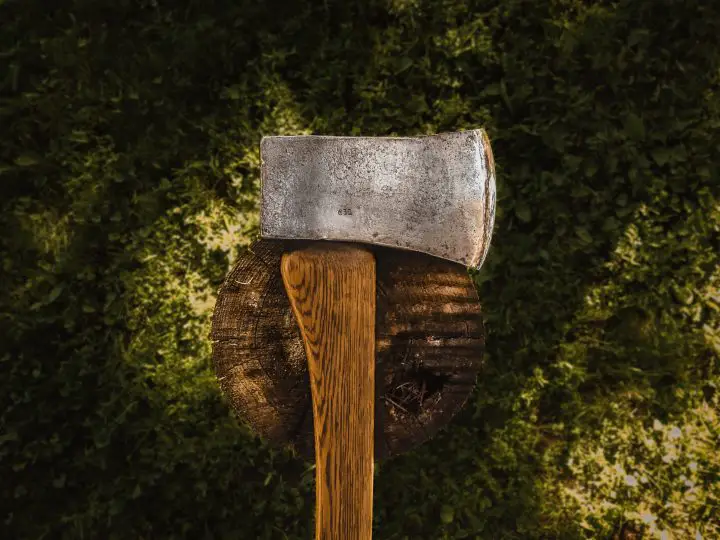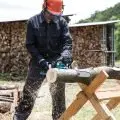Axes have a long history of use, including being used as weapons, foraging tools, and for cutting down trees. The axe is now mostly used for gardening or outdoor activities like camping, but the kind of axe you require will depend on the usage you have in mind for it.
The felling axe, commonly referred to as the American axe, is the most widely used axe in use today. This article will present the common axe patterns, various axe types, and some tips on what to consider when buying an axe.
Table of Contents
- Common Patterns of Axes
- Types of Axes (A-Z)
- 1. Adze
- 2. Broad Axe
- 3. Carpenter’s Axe
- 4. Crash Axe
- 5. Double Bit Axe
- 6. Felling Axe
- 7. Forest Axe
- 8. Grub Axe
- 9. Hatchet
- 10. Hudson Bay Axe
- 11. Hunter’s Axe
- 12. Miner’s Axe
- 13. Pick Axe
- 14. Roofing Axe
- 15. Splitting Axe
- 16. Splitting Maul
- 17. Tactical Axe
- 18. Throwing Axe
- 19. Tomahawk
- 20. Viking Axe
- Axe Types Buying Guide
- FAQs (Frequently Asked Questions)

Common Patterns of Axes
Felling axes come in a wide variety of styles, and their blade patterns are given names based on the places where they were forged. Included in these patterns are the following:
- Dayton axe
- New England axe
- Michigan axe
- Connecticut axe
Dayton Axe
The name of this pattern refers to Dayton, Ohio. These types of axes have a blade that is gently flared and bent. It is a well-liked pattern that works well for routine outdoor ax work.
New England Axe
This axe has a bottom edge that is somewhat bearded and a top edge that is straight across.
Michigan Axe
This axe, which first gained popularity in the 1860s, is a typical shape for felling axes. Its curved head makes it perfect for chopping big trees and hard woods.
Connecticut Axe
Popular axe head design that resembles a wedge with a slight flare. It works well for everyday policing tasks.
If you already have an axe at home and are wondering how to sharpen it, visit our how to sharpen an axe guide!.Learn more about the history of axes here.
Types of Axes (A-Z)
1. Adze
Technically, an adze is any hand tool with a cutting edge, although the first adzes were made in the Stone Age. These antique instruments are mostly used for woodworking, to smooth and carve wood. An adze’s blade is extremely sharp and is placed at a perfect angle for precise and intricate woodworking.
Adzes come in various varieties, but they can be divided into two groups: hand adzes and foot adzes. A hand adze will have a small handle so that it may be swung with just one hand. A foot adze will have a longer handle and be handled with both hands. The term “foot adze” refers to the height of the foot or shin where the head often lands.
- TRADITIONAL WOODCARVING TOOL: Before sawmill and powered plane tools, woodworkers, sculptors, and artists used wood carving axes called adzes; Add the Felled Curved Wood Adze to your woodworking tools to carve smooth shapes in your wood projects
Prices pulled from the Amazon Product Advertising API on:
Product prices and availability are accurate as of the date/time indicated and are subject to change. Any price and availability information displayed on [relevant Amazon Site(s), as applicable] at the time of purchase will apply to the purchase of this product.
2. Broad Axe
The term “wide axe” also refers to a tool used mostly for hewing, which is the conversion of round-edged lumber into flat-edged timber. Before the advent of industrial sawmills, this kind of carpentry was frequently employed.
This type of axe has a broad, beveled edged blade on one side with a flat side for hewing and a flat side for chopping. It is a medium-sized hand tool that carpenters now frequently use; it is now hardly seen in ordinary use.
- Hand forged in Austria for true quality they offer a life-time warranty
Prices pulled from the Amazon Product Advertising API on:
Product prices and availability are accurate as of the date/time indicated and are subject to change. Any price and availability information displayed on [relevant Amazon Site(s), as applicable] at the time of purchase will apply to the purchase of this product.
3. Carpenter’s Axe
An instrument for fine woodworking, a carpenter’s axe is not the best choice for general felling or chopping tasks. This is a little axe that is occasionally also referred to as a carpenter’s hatchet, although being a little larger than a typical hatchet. Traditionally, this kind of axe would have a flat butt that served as both a hammer and a flat, razor-sharp blade.
When choosing a carpenter’s axe, pay attention to the edge of the blade since a straighter edge indicates a higher-quality axe that will produce a better, more precise cut. Additionally, modern carpenter’s axes have a groove added to them that can be used to pry nails out of wood. Additionally, they frequently include a notch on the handle for a better grip and more precise control for the operator.
- The Axe is hand-forged and made from Swedish Axe steel using traditional methods in use since 1699
Prices pulled from the Amazon Product Advertising API on:
Product prices and availability are accurate as of the date/time indicated and are subject to change. Any price and availability information displayed on [relevant Amazon Site(s), as applicable] at the time of purchase will apply to the purchase of this product.
4. Crash Axe
An emergency equipment called a crash axe is often utilized in the event of an airplane crash landing. These axes are small, handheld tools having a smooth, serrated, or extremely sharp blade. In order to enter the aircraft from the outside or to make a hole in the aircraft from the inside if all other exits are blocked, the blade will need to be able to cut through sheet metal. A crash axe may also slice interior walls and overhead cabinets and pry gaps open.
Every airplane with 20 or more passenger seats is required to have a crash axe in the cockpit for emergency use. Others might have a separate head with a pick on it. Some crash axe varieties feature a notch on the blade that can be used to hook onto sheet metal. These axes are often made entirely of metal and are only typically owned by emergency services personnel.
5. Double Bit Axe
The head of the double-bit axe is divided into two blades, one on each side. From the front, these are often symmetrical, however one axe blade will be dull while the other is sharp. The blunt side is used to split the wood into small kindling pieces ready for the fire, and the sharp cutting edge is used to chop wood or for felling trees. These types of axes are no longer produced on a large scale and are generally only used by lumberjacks.
They are fairly hefty and difficult to carry because of the double bit axe head. Since utilizing a double bit axe requires exerting more energy than usual due to the extra head’s weight, many people opt not to use them. The twin bit axe’s advantage, however, is that it practically combines two different axes into one, freeing you from having two different axes.
- DHM-31/2H, handy axe for home, farm, dairy, sport, recreation, garden or home use
Prices pulled from the Amazon Product Advertising API on:
Product prices and availability are accurate as of the date/time indicated and are subject to change. Any price and availability information displayed on [relevant Amazon Site(s), as applicable] at the time of purchase will apply to the purchase of this product.
6. Felling Axe
These axes are made primarily for chopping timber logs and felling trees. A felling axe will have a head that weighs between two and four pounds and a long handle. This large handle gives the operator more leverage and a more powerful swing, which results in a superior cut.
Traditionally, hickory wood is used to make the handles since it is sturdy. For greater strength, the hickory grain should curve and follow the length of the handle.
A felling axe’s blade has a flared form and a point that is both thin and pointed. These should be swung diagonally at the tree trunk because they are made to cut against the grain of the wood.
Felling axes work well for their intended purpose of felling small trees and branches, but they are not the best choice for splitting because their blades have a tendency to become stuck in the wood.
Prices pulled from the Amazon Product Advertising API on:
Product prices and availability are accurate as of the date/time indicated and are subject to change. Any price and availability information displayed on [relevant Amazon Site(s), as applicable] at the time of purchase will apply to the purchase of this product.
7. Forest Axe
Strong axes designed specifically for felling trees are called forest axes. They are very heavy-duty tools that would be difficult to transport on camping trips, but they would be fantastic to keep on hand at a cabin in the woods. These axes are designed to fell particularly massive trees and feature extra-long handles. The blade of a forest axe will be pointed, flared, and have a somewhat rounded tip.
- Length with handle: 19 inch, Comes original Gransfors Axe-book
Prices pulled from the Amazon Product Advertising API on:
Product prices and availability are accurate as of the date/time indicated and are subject to change. Any price and availability information displayed on [relevant Amazon Site(s), as applicable] at the time of purchase will apply to the purchase of this product.
8. Grub Axe
A grub axe, also referred to as a “cutting mattock,” has a head with an axe on one side and an adze on the other. The longer of the two blades, the adze, will be at a horizontal angle while the axe blade will be at a vertical angle. The term “grub axe” refers to the method of using the tool, which is excellent for grubbing in rocky terrain and compacted soil. These implements are highly helpful in the garden since they may break up stubborn roots of older plants or dig holes to sow new plants in.
Prices pulled from the Amazon Product Advertising API on:
Product prices and availability are accurate as of the date/time indicated and are subject to change. Any price and availability information displayed on [relevant Amazon Site(s), as applicable] at the time of purchase will apply to the purchase of this product.
9. Hatchet
Most people own a hatchet, which is a general all-purpose axe used for simple tasks in the yard. These can cost anything from a few dollars to much than $100. They have a large handle that is often crafted from hickory wood and are quite small in comparison to certain other axes. The weighted head has a flared form that ends in a blade with a pointy tip.
A good hatchet must have balance since it will create more accurate swings and cuts, which will speed up and simplify the completion of tasks. Small trees can be cut down with a hatchet, and it can also be used to chop and split logs.
- FORGED IN ONE PIECE – The most durable, longest lasting striking tools available are crafted from a single piece of solid steel and honed into the optimal design for use.
Prices pulled from the Amazon Product Advertising API on:
Product prices and availability are accurate as of the date/time indicated and are subject to change. Any price and availability information displayed on [relevant Amazon Site(s), as applicable] at the time of purchase will apply to the purchase of this product.
10. Hudson Bay Axe
The creators of this size of medium axe were Canadian fur trappers. On lengthy journeys to the chilly north, they used it to chop firewood and as a general-purpose axe for various jobs. It is between the size of a hatchet and a full-sized felling axe in terms of size.
It works well for smaller cutting and splitting tasks and may be used with either one hand or both. Although its small makes it more portable for camping trips, it won’t be much use on larger trees.
Prices pulled from the Amazon Product Advertising API on:
Product prices and availability are accurate as of the date/time indicated and are subject to change. Any price and availability information displayed on [relevant Amazon Site(s), as applicable] at the time of purchase will apply to the purchase of this product.
11. Hunter’s Axe
The most important tool for a hunter is a hunter’s axe, which has two uses: it can chop wood and meat. In order to improve grip even when the user’s hands are wet or sticky from animal blood or rain, a good hunter’s axe will have a grooved handle.
A conventional axe would not be effective for skinning an animal since the straight blade and sharp corners could accidentally harm the hide. A hunter’s axe, in contrast, features a rounded “flay poll,” which will be more practical for skinning animals. To purchase a hunter’s axe, you would need to locate a specialized forger because they are not commonly available.
- FORGED IN ONE PIECE – The most durable, longest lasting striking tools available are crafted from a single piece of solid steel and honed into the optimal design for use.
Prices pulled from the Amazon Product Advertising API on:
Product prices and availability are accurate as of the date/time indicated and are subject to change. Any price and availability information displayed on [relevant Amazon Site(s), as applicable] at the time of purchase will apply to the purchase of this product.
12. Miner’s Axe
In the Middle Ages, miners in Europe used this axe to extract copper and silver ore from the ground. These axes have a long head and short grip, making them perfect for usage in confined spaces. These axes may have had highly complex etching on the head that became a status symbol among miners throughout the years.
- 3.5 lb Miners SB Axe Dayton Pattern; 20 inch Straight Wooden Handle; 4 inch Blade; 3 1/2 lb Head
Prices pulled from the Amazon Product Advertising API on:
Product prices and availability are accurate as of the date/time indicated and are subject to change. Any price and availability information displayed on [relevant Amazon Site(s), as applicable] at the time of purchase will apply to the purchase of this product.
13. Pick Axe
A pickaxe is a hand tool with a “T” form. It has a double metal head on top of a hardwood or fiberglass handle. Traditionally, the pick would be on both sides of the head; however, modern pickaxes typically have a pointed pick on one side and a chisel on the other. The pick end may occasionally be fully straight or may have a slight curvature to it.
A pickaxe is a helpful tool for gardening and landscaping that is mostly used to break up hard soil, rocks, or concrete. In contrast, a chisel is frequently used to pry out cracks in the ground or spaces between boulders. In addition to acting as a weight to balance the axe, the chisel also gives the pick more momentum as it is swung.
- Ideal for breaking up rocky surfaces such as gravel and hardened, dried earth (pointed end), or for use as a hoe when digging in tough soil (flat end)
Prices pulled from the Amazon Product Advertising API on:
Product prices and availability are accurate as of the date/time indicated and are subject to change. Any price and availability information displayed on [relevant Amazon Site(s), as applicable] at the time of purchase will apply to the purchase of this product.
14. Roofing Axe
Although it has lost favor due to contemporary inventions, many roofers still appreciate the high-quality craftsman’s tool known as a roofing axe, often referred to as a roofing hatchet. If you’re on top of a roof and don’t want to be dragging around a lot of different tools, a roofing axe’s various uses are perfect.
On either side of the handle of the roofing axe are two heads. A razor-sharp blade on one head is used to cut roofing shingles. The hammer head on the other end is used to drive roofing nails into the roof to attach the shingles.
Often, the hammer head is magnetized, so you may attach the nails to the front of the hammer and ram them in without having to keep them in place. A node on the side with the sharp blade is another hallmark of roofing axes.
With the hammer head pointing upward, you can use this node, a shingle gauge, by hooking it over the front face of the shingle beneath the one you are setting. This allows you to have rows of shingles that are evenly spaced apart, the following shingle should rest up against the hammer head.
- High carbon steel shingling hatchet with genuine hickory handle - Built for roofers, contractors, framers, and the DIY inclined
Prices pulled from the Amazon Product Advertising API on:
Product prices and availability are accurate as of the date/time indicated and are subject to change. Any price and availability information displayed on [relevant Amazon Site(s), as applicable] at the time of purchase will apply to the purchase of this product.
15. Splitting Axe
Splitting axes tend to be lighter and less blunt than splitting mauls. However, the aim of both axes is the same—splitting wood. Few splitting axes have hardened polls that enable them to be used as hammers, in contrast to many mauls, which rely more on the shape and strength of the bit to split wood.
- Designed for splitting medium to large-sized logs, with maximum efficiency for more one-strike splits; Ideal for taller users
Prices pulled from the Amazon Product Advertising API on:
Product prices and availability are accurate as of the date/time indicated and are subject to change. Any price and availability information displayed on [relevant Amazon Site(s), as applicable] at the time of purchase will apply to the purchase of this product.
16. Splitting Maul
These axes were created primarily to cut wood into kindling. They resemble a felling axe in design and feature a long wooden handle for a powerful stroke. Instead of swinging the splitting maul sideways like you would a felling axe, you should swing it downward. Splitting mauls produce split wood rather than chopped wood, in contrast to felling axes, which cut against the grain of the wood.
The head is shaped like a thick wedge, with one sharp end and one blunt end. The sharp end doesn’t need to be very sharp to be useful, as the majority of the work will be done by the weight and form of the blade. Because they can function effectively even when rather blunt, splitting mauls require far less regular sharpening than other axes.
Prices pulled from the Amazon Product Advertising API on:
Product prices and availability are accurate as of the date/time indicated and are subject to change. Any price and availability information displayed on [relevant Amazon Site(s), as applicable] at the time of purchase will apply to the purchase of this product.
17. Tactical Axe
Modern technology has given us the tactical axe, which functions somewhat like a multi-tool. This axe, often referred to as a tactical tomahawk, is becoming more and more popular among law enforcement officers, soldiers, security personnel, and survivalists.
This axe is mostly used for chopping, but it may also be used as a shovel, a pry bar, a hammer, and a close-range weapon. It works well for camping vacations because it makes it easier to cook, chop wood for campfires, and dig holes. These axes are often built of steel so they have the durability to handle a variety of jobs.
- THE ULTIMATE IN TOMAHAWKS: Tactical hatchet is a great addition to any tactical belt or camping kit; Camping hatchet’s stainless steel blade comes pre-sharpened and ready for the wild
Prices pulled from the Amazon Product Advertising API on:
Product prices and availability are accurate as of the date/time indicated and are subject to change. Any price and availability information displayed on [relevant Amazon Site(s), as applicable] at the time of purchase will apply to the purchase of this product.
18. Throwing Axe
In the middle ages, foot soldiers wielded the original throwing axe as a weapon in combat, which was hurled at an adversary to deal lethal injury. Axe throwing has gained popularity as a competitive sport in recent years since it was first introduced. The axes used in this sport might range in form and design, but their key characteristic is that they must be exceedingly strong and robust to withstand the strain from repeated throws.
A throwing axes handle must be a specific length in order to comply with the rules established by the league or federation that is organizing the event. Depending on your skill level in the sport, you can purchase a variety of axes for throwing, such as beginner to intermediate axes or more advanced axes for those with more experience. These axes come in a range of prices, but generally speaking, the more money you spend, the higher quality axe you will get.
- Patent pending locking mechanism makes handle changes easy: all you have to do is to loosen the bolts, slip out the worn handle and exchange it for a new one and re-tighten the bolts
Prices pulled from the Amazon Product Advertising API on:
Product prices and availability are accurate as of the date/time indicated and are subject to change. Any price and availability information displayed on [relevant Amazon Site(s), as applicable] at the time of purchase will apply to the purchase of this product.
19. Tomahawk
Native Americans in North America are the original users of tomahawk axes. Since their inception, they have been utilized in warfare by both sides in the American Revolution and later in the Vietnam War. They have a long military history. These axes resemble hatchets, but they are substantially lighter and feature a totally straight handle.
They are easier to throw during fighting because of their straight handles, and their sharp blades can be used for a variety of tasks, such as digging, prying, chopping, and splitting. Tomahawks are common among military, but more lately, they have also become popular for camping.
They are easier to carry along because they are smaller and lighter than hatchets. They can be utilized for a variety of bushcraft tasks because they are multipurpose. Additionally, tomahawks have their own category in knife throwing contests.
- Suitable for re-enactors from any period stretching from the French and Indian War clear up to the final settling of the West in the late 1800’s, our Frontier Hawk is a joy to use
Prices pulled from the Amazon Product Advertising API on:
Product prices and availability are accurate as of the date/time indicated and are subject to change. Any price and availability information displayed on [relevant Amazon Site(s), as applicable] at the time of purchase will apply to the purchase of this product.
20. Viking Axe
Throughout the entirety of the Viking Age, axes were utilized in combat. You wouldn’t be right to think that Viking axes were brutish and heavy, despite the fact that many of them were huge. Axes created by the Vikings were often very well balanced and rarely weighed more than two pounds, making them easy to carry and deploy quickly in combat. These axes came in a wide range of sizes, but the majority were double-handed and had handles as lengthy as 55 inches.
Viking axe heads may have had a variety of shapes, but they are most famous for having thick beards. This form was helpful in combat for a number of purposes, such as catching an opponent’s ankle to knock them over or hooking their shield out of the way to leave them defenseless.
Extremely sharp blade ends allowed them to slit throats like knives, while the flat butt of an axe was also used, generally to strike targets in the head for humiliating but non-lethal blows. The handles were often constructed of wood, but the heads were almost always made of iron. The study of these axes helps us understand earlier civilizations even though they are no longer employed.
- ⚔️ NORSE STYLING - This new and improved** Viking axe draws inspiration from Viking artifacts, this Viking replica axe features hand carved Norse Elder Futhark runes along its aged hardwood shaft.
Prices pulled from the Amazon Product Advertising API on:
Product prices and availability are accurate as of the date/time indicated and are subject to change. Any price and availability information displayed on [relevant Amazon Site(s), as applicable] at the time of purchase will apply to the purchase of this product.
Axe Types Buying Guide
Of course, as you’ve just learned, there are a variety of axes besides the well-known felling axe. You should take into account the following when looking for the ideal axe for you:
Handle
Although axes with rubber handles are increasingly being sold at large box retailers, the greatest axes still have hardwood handles. An ergonomically better and more durable handle is one made of wood. Look for a handle made of hickory or ash for the highest quality.
Size
The size of an axe handle should ideally depend on how it will be used. This is a hotly discussed issue. A longer handle on a felling axe will result in a bigger swing and more leverage, whilst a shorter handle will produce better accuracy.
Full-sized felling axes typically measure 36 inches in length, although for most users, this should be the longest length to consider. A handle of about 32 inches would be ideal for a person who is six feet tall because it will provide a decent balance between precision and force.
Weight
The use of the axe head will be impacted by its weight. It won’t cut very deeply if it’s too light, but if it’s too heavy, you’ll gain force but lack precision. The head of your first axe shouldn’t weigh more than three pounds, and as you gain more experience, you can progress to heavier ones.
FAQs (Frequently Asked Questions)
What are little axes called?
Small axes are known as hatchets. These are light axes which are designed for use in one hand specifically while camping or travelling. Carpenter’s axes are also small and are used in traditional woodwork, but are usually slightly larger than a hatchet.
What are the different types of axe handles?
When discussing different types of axe handles, we can discuss their style, ends, and shape. Axe handles can be straight or curved. While the handle shapes can be either oval or octagonal, the ends of the handles frequently have either a scroll or swell knob or a “fawn foot” design. Axe head weight, size, and personal choice all play a role in determining how long the handle should be.
What do you call an axe with a long handle
Splitting axes have a long wooden handle that provides the user with the leverage they need to make a strong stroke. The main use of splitting axes, also known as splitting mauls, is to split and chop firewood.
























